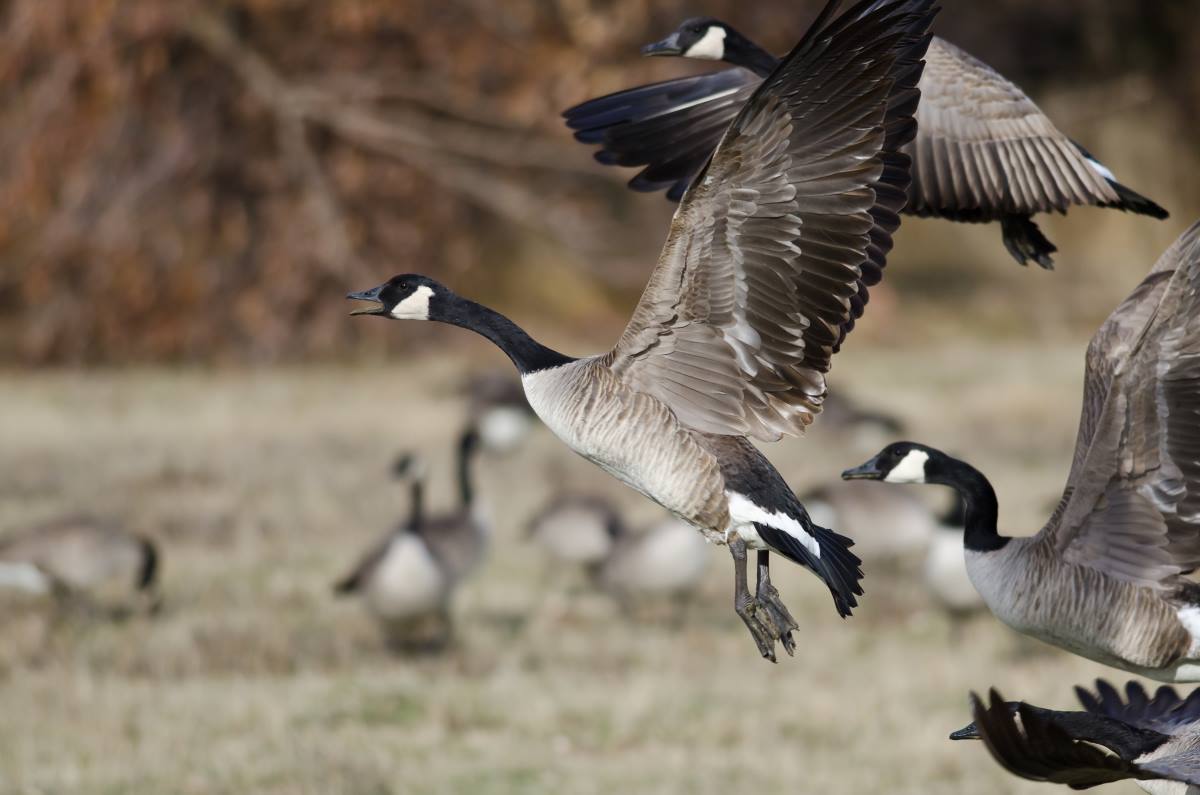10 Beginner Tips for Hunting Iowa Geese

10 Beginner Tips for Hunting Iowa Geese
Every fall, whether I’m in the stand chasing whitetails with my bow or at work watching a flock of honkers work back to the roost at the end of the day, my eyes often follow that classical V-formation that has been mesmerizing me for years. Fast forward ahead to the 2025 hunting season, I’m geared up and ready for the flocks of geese to cup their wings and head to land in my decoy spread. Here’s how to create a successful hunt, whether you’re an experienced hunter or a beginner trying to land your first birds.
Huntable Species
Goose species in Iowa are designated into two distinct categories: dark and light geese. Dark geese include Canada geese, greater white-fronted geese, commonly known as specklebellies, and brants. These geese are hunted primarily during the migration, with the exception of the urban hunting season in select metropolitan cities across the country, like Des Moines and Cedar Rapids. Light geese include snow geese (both white and blue-phase) and Ross’ geese. These species are also hunted during the fall migration, like dark geese, with a special spring season called the Light Goose Conservation Order (LGCO). This season opens the day after the fall season closes.
The fall season is split into three zones the earliest starting in the North Zone, followed by the Central Zone, and lastly the South Zone. The North Zone is the area of Iowa north of a line beginning on the South Dakota-Iowa border at Interstate 29, southeast along Interstate 29 to State Highway 20 to the Iowa-Illinois border. The South Zone is the area of Iowa west of Interstate 29 and south of State Highway 92 east to the Iowa-Illinois border. The Central Zone is the remainder of the state between the North and South Zones.
Guns and Shot Loads
A great starting point for any waterfowl hunter with geese is what gun and what shot load to use. Typically, a 12-gauge shotgun is used for taking down geese, considering some mature Canadas can push the scale to 12-15 pounds. A 20-gauge is doable, but you’re going to want that power to really knock down your limit. Gun manufacturers like Weatherby, Winchester, and Benelli have been producing shotguns that are great for any hunter.
Another thing to consider is your shot size. Goose loads come in shot sizes of 2, 1, B, and BB and in sizes of 3”- and 3-½”-shells. Stacked loads are another option to consider with waterfowl like geese for an extra knockdown. Recommended brands like Hevi-Shot and Migra are excellent choices to begin with. Always make sure to use non-toxic shot like steel, bismuth, or tungsten when hunting geese, and a plug is required to use in the magazine of your shotgun, with the exception of the LGCO.
Scouting
Remember this if you can only take one thing from this article: if you don’t scout, you will not find birds. It’s just that simple. The same principle that is used during the summer for patterning whitetails can be applied to finding roosts, loafing areas, and feeds, and singlehandedly improve your results for future hunts. Having a good pair of binoculars is crucial, so never leave them behind on a scouting mission. When you’ve located the birds, take note of the number in the flock. This will be instrumental in the steps to come.
Decoy Set-up
These are a must for getting birds to work into your spread. Whether you’re hunting over water or over a cut corn field, decoys will bring confidence to wary flocks that have faced pressure during migration. Decoy types include full bodies, shells, silhouettes, socks, and floaters. Most decoys also come with a specific posture, which can narrow down what to use, especially when scouting the flock from days before. Full bodies, silhouettes, and shells are very general to a field or water hunt, whereas socks and floaters may be more specific to the type of hunt you plan to do.
Try to replicate the same number of decoys to create a comfortable environment for the birds to land. In a field, try to make an X-, Y, or Z-formation, positioning yourself to how you intend the birds to land. In a water scenario, try positioning your decoys in a U-formation to make a pocket for the birds to land. Be sure to use the wind to your advantage for a landing zone and, most importantly, give the birds room space to land in your decoys.
Concealment
Geese have incredible eyes, so staying hidden is imperative to a successful hunt. When hunting cut agricultural fields, try using a layout blind to keep a low profile to the ground. Most layout blinds also have loops that will let you insert material like corn stubble and grasses to increase optimal cover to elude the eyes above. Another great solution is to buy square bales off of your local farmer. If you’re lucky, you won’t have to worry about camouflage for the rest of the season at a minimal cost.
A-frame blinds are also popular with hunting field edges and water. A good material to use is switchgrass. It provides a great showy appearance that helps make your blind look inconspicuous to oncoming flocks. Be sure to know what you plan to cut for your blind and contact local conservation agencies that your switchgrass harvest is approved. Most sporting stores will also provide blind covers from anything listed above to big boat blinds.
Calling Birds
Calling is just as influential to bringing in geese as decoys and concealment are to your hunt. Going back to scouting, listening to how birds vocalize with one another is the difference between you seeing birds to fill your limit for the day. There are numerous tutorials on the internet that can help you understand the difference between clucks and moans and how to use them together in a sequence. Practice is also key to getting better at calling. Always take time in the offseason to tune up your cadence or learn new calls you’ve never tried before.
A great local company to check out is Iowa Hunting Products in Newton, Iowa, which specializes in game calls here in our great state.
Private versus Public
A good majority of great goose hunting is going to take place on private ground. As discussed before, geese frequently fly to cut ag fields to feed. As hunters, it is our responsibility to seek out permission to get access to hunt.
An easy tool for Iowans wanting to see who owns property is a website called Beacon-Schneider Corps. This allows hunters to access the name of the landowner and their property’s boundaries.
When asking permission to hunt another person’s property, maintain a friendly attitude, show you mean well, and tell the landowner who you are. If you intend to bring more than yourself to a hunt, be sure to let them know how many people you plan to bring with you, as well as their vehicles and yours. The worst they can say is no, and the best thing to do is to turn the other cheek.
The Iowa DNR provides hunters with over 410,000 acres of public land. They have an online atlas that allows you to navigate between DNR and county-owned public hunting land. Always remember to do your research and respect property boundaries.
Camouflage and Waders
What camouflage you wear is entirely dependent on the habitat you plan on hunting. Companies make brilliant patterns to help you blend in with your surroundings in both wetlands and ag fields. A pair of insulated waders will go a long way in the later seasons and benefit immensely in water hunts.
Dogs in the Field
Having a trained dog or knowing someone who has a trained dog will make a difference in a hunt. Breeds like Labrador Retrievers, Griffons, and Golden Retrievers are popular waterfowl dogs, to name a few. Remember, when purchasing and getting a dog, training is key, so make time to practice with your pup and build confidence as they grow and learn.
Join a Conservation Organization
There are multiple conservation organizations in Iowa that hold groups, or chapters as they’re called, in certain regions of the state. Joining an organization Ducks Unlimited or Delta Waterfowl will expand your knowledge of waterfowl hunting and networking with like-minded sportsmen and hopefully create friendships along the way. The volunteer work they do helps conserve the very lands we want for habitat and reproduction for waterfowl species across the United States, and helps keep the sport going with educational outreach and workshops.
Goose hunting is a sport that holds a deep and rich tradition in many communities around the country. I hope these tips help you bag more geese, create more memories, and keep fueling the fire that drives us all to chase those birds across the Hawkeye State. Good luck and happy hunting!
By Cole Rozendaal
October 2025
Check out these helpful fly-fishing tips to keep in mind.
Or if you are looking for the digital version of this months issue here it is below
Looking for the Cattle/Dairy side of things


